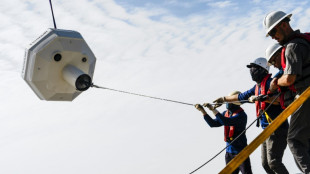
-
 Indonesia considers parole for ex-terror chiefs: official
Indonesia considers parole for ex-terror chiefs: official
-
Postecoglou says Spurs 'need to reinforce' in transfer window

-
 Le Pen says days of new French govt numbered
Le Pen says days of new French govt numbered
-
Villa boss Emery set for 'very difficult' clash with Newcastle

-
 Investors swoop in to save German flying taxi startup
Investors swoop in to save German flying taxi startup
-
How Finnish youth learn to spot disinformation

-
 12 killed in blast at Turkey explosives plant
12 killed in blast at Turkey explosives plant
-
Panama leaders past and present reject Trump's threat of Canal takeover

-
 Hong Kong police issue fresh bounties for activists overseas
Hong Kong police issue fresh bounties for activists overseas
-
Saving the mysterious African manatee at Cameroon hotspot

-
 India consider second spinner for Boxing Day Test
India consider second spinner for Boxing Day Test
-
London wall illuminates Covid's enduring pain at Christmas

-
 Poyet appointed manager at South Korea's Jeonbuk
Poyet appointed manager at South Korea's Jeonbuk
-
South Korea's opposition vows to impeach acting president

-
 The tsunami detection buoys safeguarding lives in Thailand
The tsunami detection buoys safeguarding lives in Thailand
-
Teen Konstas to open for Australia in Boxing Day India Test

-
 Asian stocks mostly up after US tech rally
Asian stocks mostly up after US tech rally
-
US panel could not reach consensus on US-Japan steel deal: Nippon

-
 The real-life violence that inspired South Korea's 'Squid Game'
The real-life violence that inspired South Korea's 'Squid Game'
-
Blogs to Bluesky: social media shifts responses after 2004 tsunami

-
 Tennis power couple de Minaur and Boulter get engaged
Tennis power couple de Minaur and Boulter get engaged
-
Supermaxi yachts eye record in gruelling Sydney-Hobart race

-
 Hawaii's Kilauea volcano erupts, spewing columns of lava
Hawaii's Kilauea volcano erupts, spewing columns of lava
-
El Salvador Congress votes to end ban on metal mining

-
 Five things to know about Panama Canal, in Trump's sights
Five things to know about Panama Canal, in Trump's sights
-
NBA fines Minnesota guard Edwards $75,000 for outburst

-
 Haitians massacred for practicing voodoo were abducted, hacked to death: UN
Haitians massacred for practicing voodoo were abducted, hacked to death: UN
-
Inter beat Como to keep in touch with leaders Atalanta

-
 Man Utd boss Amorim questions 'choices' of Rashford's entourage
Man Utd boss Amorim questions 'choices' of Rashford's entourage
-
Trump's TikTok love raises stakes in battle over app's fate

-
 Is he serious? Trump stirs unease with Panama, Greenland ploys
Is he serious? Trump stirs unease with Panama, Greenland ploys
-
England captain Stokes to miss three months with torn hamstring

-
 Support grows for Blake Lively over smear campaign claim
Support grows for Blake Lively over smear campaign claim
-
Canada records 50,000 opioid overdose deaths since 2016

-
 Jordanian, Qatari envoys hold talks with Syria's new leader
Jordanian, Qatari envoys hold talks with Syria's new leader
-
France's second woman premier makes surprise frontline return

-
 France's Macron announces fourth government of the year
France's Macron announces fourth government of the year
-
Netanyahu tells Israel parliament 'some progress' on Gaza hostage deal

-
 Guatemalan authorities recover minors taken by sect members
Guatemalan authorities recover minors taken by sect members
-
Germany's far-right AfD holds march after Christmas market attack

-
 Serie A basement club Monza fire coach Nesta
Serie A basement club Monza fire coach Nesta
-
Mozambique top court confirms ruling party disputed win

-
 Syrian medics say were coerced into false chemical attack testimony
Syrian medics say were coerced into false chemical attack testimony
-
NASA solar probe to make its closest ever pass of Sun

-
 London toy 'shop' window where nothing is for sale
London toy 'shop' window where nothing is for sale
-
Volkswagen boss hails cost-cutting deal but shares fall

-
 Accused killer of US insurance CEO pleads not guilty to 'terrorist' murder
Accused killer of US insurance CEO pleads not guilty to 'terrorist' murder
-
Global stock markets mostly higher

-
 Not for sale. Greenland shrugs off Trump's new push
Not for sale. Greenland shrugs off Trump's new push
-
Acid complicates search after deadly Brazil bridge collapse


California blaze raises fears for dangerous wildfire season
California firefighters on Monday tackled the state's biggest blaze of the year so far, as fears intensify over ominous conditions forecast for the hot, dry months ahead.
The inferno just north of Los Angeles rapidly burned through almost 15,000 acres (60 square kilometers) over the weekend, forcing the evacuation of more than a thousand campers from a recreational park and the closure of a popular boating lake.
Some 1,150 firefighters were working to contain the so-called "Post Fire," dousing the flames from seven air tankers and constructing perimeter lines, but it remained just eight percent contained by Monday morning.
The blaze is "exhibiting extreme fire behavior," warned the National Interagency Fire Center, with low visibility and winds of up to 50 miles (80 kilometers) per hour impeding firefighters' efforts.
It was one of around a dozen mostly smaller fires to ignite over a weekend in California that saw high temperatures, low humidity and gusty winds.
The blazes come at the start of a potentially critical time for the notoriously fire-prone region.
In the western United States, recent wet winters have prompted the rapid growth of vegetation, which experts warn could prove dangerous as it dries out in the weeks and months ahead.
Grasses and trees in parts of California are already "sufficiently dry to support elevated fire weather concerns, and recent fire activity suggests that fuels are drying quickly and supportive of fire spread," said the National Weather Service.
"As the result of two consecutive wet winters, there is a lot of additional growth, particularly of grass, but also, to a lesser extent, of heavier brush too," said Daniel Swain, a climate scientist with the University of California, Los Angeles.
"Those grasses are starting to dry out," although this early in the summer there is still some moisture, he added.
Wildfires are a natural -- and necessary -- part of the region's life cycle.
But climate change, caused by humanity's burning of fossil fuels -- which releases greenhouse gasses into the atmosphere -- is making extreme weather conditions more intense and frequent.
A potentially historic heat wave is set to hit vast swaths of the central and eastern United States this week, where temperatures are expected to be unseasonably high for June.
Scorching temperatures have already broken early summer records in the western United States.
Earlier this month Las Vegas recorded a 111 degree Fahrenheit (44 degrees Celsius) day earlier in the year than ever before.
Some 42,000 acres have already burned in California this year -- around 50 percent higher than the five-year average by this point in the year.
Echoing a national trend, wildfires in 2024 have been fewer in number, but larger in size, than in recent years.
J.Oliveira--PC




